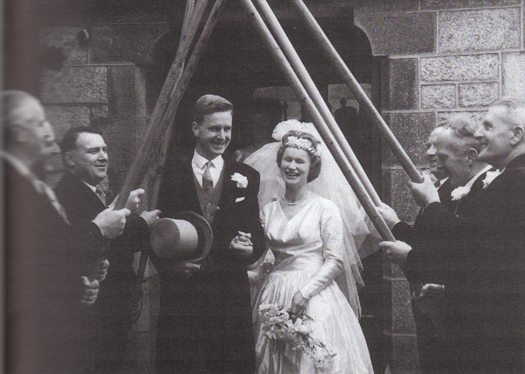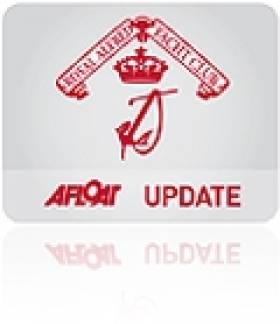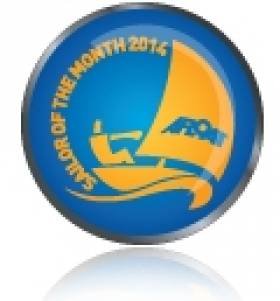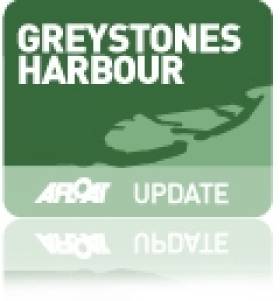Displaying items by tag: Hal Bleakley
Royal Alfred Yacht Club Toasts Winners At Annual Dinner in the Royal Irish Yacht Club
#rayc – The Royal Alfred Yacht Club held its Annual Black Tie Dinner and Prize-giving on Friday 21st November in the Royal Irish YC in Dun Laoghaire.
A packed dining room was treated to an excellent meal, fine wines and after the prizegiving a short presentation by Liam Coyne of his incredible Round Britain and Ireland odyssey in which he came first in the two-handed class and came sixth overall.
The Alfred's Trophies, some of which date back to the mid 1800s, were presented by Commodore Barry MacNeaney.
He paid tribute during his speech to the late, and much missed, Henry Robinson: he also toasted one of his distinguished guests Hal Bleakley who had announced his retirement from DBSC race officer duties at the end of the 2014 season.
The Royal Alfred is one of the very few Clubs to award crew prizes as well as those to the skipper – this for the Superleague.
And these prizes were very well received by the many crew who attended the dinner.
The success of the evening may be judged by the lateness of the hour that the last revellers left the Royal Irish!
Scroll down for prizewinners photos by Joe Fallon

Barry MacNeaney , Carol MacNeaney, Nigel Biggs Winner Cruisers 2 and Deborah Horan

Carol MacNeaney, Joe Carton Vice Commodore RAYC, Mona Carton and Barry MacNeaney

Selection of RAYC trophies

Ben Shanahan winner Gold Fleet Lee Overlay Trophy for RAYC Coastal Series, Carol MacNeaney

Trina Owens, Carol MacNeaney and John Sugars winner Beneteau 31.7 Trophy

Tim Goodbody winner Sigma 33 "Princess Jalina" Trophy, Carol MacNeaney and Barry MacNeaney
Hal Bleakley, Sailor of the Month for September 2014
#som – On Saturday 27th September, Hal Bleakley quietly retired from a lifetime of service to yacht racing, standing down after his final day as Race Officer for Dublin Bay Sailing Club in the last race of the summer programme in the Club's 130th year of playing a key role in the bay.
Hal Bleakley personifies all that is best in DBSC, and indeed in Irish sailing and the maritime community generally. He got steadily on with the job with hours, days and weeks of often voluntary effort, and it was usually done quietly in the background, for that was Hal's way. In his working life, he was a leading figure in technical management and general administration in Ireland's aviation industry from 1959 to 2000, and he brought the high standards of his profession to his many interests afloat.
Thus it was entirely appropriate that he should serve as the Launching Authority for Dun Laoghaire lifeboat, one of the busiest RNLI stations in the country. Equally, he served on the officer board of his beloved Dublin Bay Sailing Club, rising to be Commodore, while his own greatest sailing passion was in the Mermaid Class.
From a sailing background himself, he married into theMermaids when he wed Jane Daniel, daughter of Mermaid stalwart Ken Daniel, with the newly-weds exiting the church through an archway formed by Mermaid spinnaker poles held aloft by top Mermaid helmsmen. The young couple continued for very many years to race enthusiastically in the class, and they won the John B Kearney Cup in 1990.
But although very Dun Laoghaire-based, the Bleakleys were keenly aware of the Mermaid class's healthy spread in other localities. So when they presented the Daniel Perpetual Memorial Trophy, it was for the best overall result (with three discards) at the regattas of the National YC, their own club the Royal St George YC, the Royal Irish YC, Wexford, Skerries, Foynes, Clontarf and Rush.
In the days when Mermaid numbers were at their peak, Hal's technical expertise was invaluable in providing unquestioned methods of measurement both for length and weight, and his calm presence in a Committee Boat inevitably led to increasing calls on his time for Race Officer duties.
As for the day job, when he retired from the aviation industry, it was a surprise to everyone, for with his youthful appearance, he certainly didn't look like someone of retirement age. But needless to say, his technical and management skills were soon deployed elsewhere, and he was the popular choice as first manager of the new Dun Laoghaire Marina when it opened in 2001, a challenging role which he ably filled with diplomacy, management skills, and technical expertise.
Under his stewardship between 2001 and 2010, Dun Laoghaire Marina expanded from 275 berths in 2001 to 820 in 2007, and in 2008 it was internationally acclaimed with five Gold Anchor Awards by the Yacht Harbour Association. Within Ireland's marine industry, he was a founder Member and Chairman of the Irish Marina Operators Association, and he also served as a Board Member with the Irish Marine Federation.
On sea and on land, Hal Bleakley's contribution to our sport and our boating facilities is immense, and we've no doubt we'll see him happily absorbed in and around boats in the years ahead as he enjoys retirement from voluntary service and work afloat. Meanwhile, heartfelt thanks and very best wishes from the sailing community

Hal and Jane Bleakley at their wedding, exiting the church through an archway of Mermaid spinnaker poles held aloft by Geoff Ashenhurst, Terry Roche, Frank Farley, Johnny Walker, Ronnie Kay, and Flick Hardy. Photo from "The Dublin Bay Mermaid" by Paul Smyth.
80% of Berths Required in Greystones are Under 8 Metres
A newsletter giving details of the most popular size berth requirements at the proposed Greystones Harbour Marina has been sent to boat owners on a waiting list for the Wicklow marina.
The analysis finds 80% of the berths required are under 10 metres (32 foot). Only 2 berths were required for boats over 13m (42 feet).
In nearby Dun Laoghaire, at the country's biggest marina, the 820 berths there range in size from 6m (19 feet) to 30m (98 feet). The average berth requirement on Dublin Bay is 9-10m (29-32 feet).
The March newsletter says examination of the waiting list revealed duplication of an original waiting list which prompted a fresh exercise to establish the current market demand in 2011. The new survey of 300 people was carried out by a marina consultant, working for developer Sispar. It delivered 79 responses. An extract from the analysis is below.
The tabulation from the newsletter reflects the breakdown of the responses in terms of current berth size numbers and the extrapolation into the requirement for totals when fully developed based on to-days statistics.
| Berth Size | Numbers to 6/1/11 | % of Current Market | Full Dev Berth Nos. |
|
| <6m | 9 | 12.4 | 29 | |
| 6-7m | 12 | 15.2 | 35 | |
| 7-8m | 14 | 17.7 | 41 | |
| 8-9m | 5 | 6.3 | 15 | |
| 9-10m | 17 | 21.5 | 50 | |
| 10-11m | 8 | 10.1 | 24 | |
| 11-12m | 6 | 7.6 | 18 | |
| 12m-13m | 6 | 7.6 | 18 | |
| >13m | 2 | 2.6 | 5 | |
| Total | 79 | 101 | 235 |































































